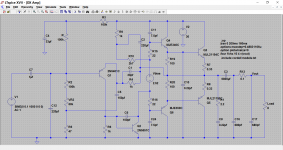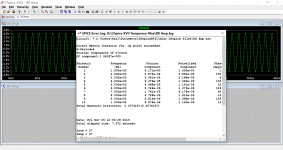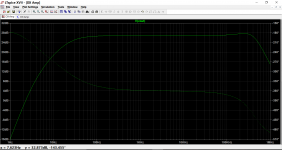Forget big bass handling with any class A amplifier, because it has by far the greatest power requirement but least requirement for sound quality. 20-30W is only 3db louder than 10-15W so the difference won't be significant. If you must have everything in class A though, consider a Krell clone like a KSA 50 kit for real power. Otherwise, use a subwoofer if you really need a bigger amplifier with solid bass - save the class A handling for the upper bass and midrange, where it really matters 🙂The greatest limit of dx is bass response...so i was looking for a way to pump it
Last edited:
Ovation sx-Amplifier: A 15 W RMS class A Current Feedback Amplifier
You can run this amp from +/- 30V rails, reduce the idle current to class AB (2-300 mA) easily get 25-30W from it, still sounds very-very good. One of the best sounds I ever got from an SS amplifier...
You can run this amp from +/- 30V rails, reduce the idle current to class AB (2-300 mA) easily get 25-30W from it, still sounds very-very good. One of the best sounds I ever got from an SS amplifier...
Forget big bass handling with any class A amplifier, because it has by far the greatest power requirement but least requirement for sound quality. 20-30W is only 3db louder than 10-15W so the difference won't be significant. If you must have everything in class A though, consider a Krell clone like a KSA 50 kit for real power. Otherwise, use a subwoofer if you really need a bigger amplifier with solid bass - save the class A handling for the upper bass and midrange, where it really matters 🙂
my friend, dx trust amp is NOT a class A amp...
but the circuit is made to sound with high efficency speakers...that is only one way for that amp, it is low biased, and bass limited....I would to find where is bass limitation and remove it.
you also can read from author's page that frequency response is flat from 40hz-25khz on 8ohm....why???? how can I improve bass response?
True bass limitation comes from the various time constants within the design, the input coupling cap, the feedback return cap and the speaker coupling cap.
Bias should be around 70ma for a design like this.
Bias should be around 70ma for a design like this.
Yes!
So i need to recalculate the two feedback caps. One is 150uf and the other is 220uf. Any help?
So i need to recalculate the two feedback caps. One is 150uf and the other is 220uf. Any help?
he declares input impedance is 40k.
I think it is a very optimistc value...in order to calculate input cap
I think it is a very optimistc value...in order to calculate input cap
Yes, correct. My apologies for confusing them because I assumed this was the same as my suggestions in the Trust thread and the low voltage supply is consistent with only about 17W - unusual for class AB. Even in class AB, though, you still need a >50V supply and a few parts changes to get power like 30W. If you want more bass, more output power is still going to be needed.my friend, dx trust amp is NOT a class A amp...
Changing C2 will change the bass roll-off frequency via the feedback network but frequency response should not be determined there. C1/R2 is the place to set the lower frequency limit but that should be ok as is. I don't know where this 40Hz lower roll-off frequency comes from. There are a lot of anomalies here and I don't think this is a good design to tinker with, as others are saying too.
You might try it for yourself in simulation, using free programs like Ti-TINA (easy) or LTspice (for advanced users) if you wan't to learn a little about audio electronics and setting the basic parameters of amplifiers.
Yes!
So i need to recalculate the two feedback caps. One is 150uf and the other is 220uf. Any help?
he declares input impedance is 40k.
I think it is a very optimistc value...in order to calculate input cap
Which circuit are we working to ? The one a few posts back has 330uf as the feedback return.
It's the usual problem of assuming we can all read minds.Which circuit are we working to ? The one a few posts back has 330uf as the feedback return.
Just reference the sch by post number, or attach a copy of the sch. Saves so much guessing.
I am struggling to read the capacitor numbers, so I just counted the electrolytics.
I see 5 electros. All of these will in some way influence the way the amplifier performs.
Include the input AC coupling cap and you find you will need to assess all 6 capacitors to find which are the worst bottlenecks to bass performance.
I recommend you do not build this DX Trust amplifier. Much like all the other DX amps it is designed poorly.
I see 5 electros. All of these will in some way influence the way the amplifier performs.
Include the input AC coupling cap and you find you will need to assess all 6 capacitors to find which are the worst bottlenecks to bass performance.
I recommend you do not build this DX Trust amplifier. Much like all the other DX amps it is designed poorly.
The schematic is at post #31.
Maybe the design is poor, but I m asking any help for this deign that I like very much...so please should you giive any help? If not, I dont see any reason for you to write here...Not need to be redirected to other amps, I know there are many ones much better sounding.
Maybe the design is poor, but I m asking any help for this deign that I like very much...so please should you giive any help? If not, I dont see any reason for you to write here...Not need to be redirected to other amps, I know there are many ones much better sounding.
The schematic is at post #31.
Maybe the design is poor, but I m asking any help for this deign that I like very much...so please should you giive any help? If not, I dont see any reason for you to write here...Not need to be redirected to other amps, I know there are many ones much better sounding.
Come back in 15 minutes and I'll simulate it for you.
- Status
- Not open for further replies.
- Home
- Amplifiers
- Solid State
- solid state diy amp 20-30w high quality



